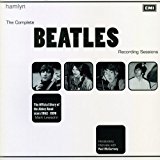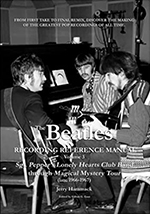On May 25 and 31, 1967, The Beatles recorded George Harrison’s composition titled “It’s All Too Much,” at De Lane Lea Music Recording Studios.
On this day, which was the official release date of their album “Sgt. Pepper” (although it was available in UK stores a few days before), the band returned to De Lane Lea and spent some time doing various improvisations. These improvisations were described in the following terms by Mark Lewisohn:
On this day, 1 June 1967, perhaps the most celebrated day in their career, the Beatles went into the studio and recorded nothing but untitled, unplanned, highly tedious and — frankly — downright amateurish instrumental jams, with a bass guitar, an organ, lead guitar with reverb, guitar strings being scraped, drums and tambourine.
From “The Complete Beatles Recording Sessions” by Mark Lewisohn, 1988
The day after, June 2, they resumed their work on “It’s All Too Much“, still at De Lane Lea.
From Wikipedia:
Warner Bros. De Lane Lea Studios is a recording studio, based in Dean Street, Soho, London.
Although the studios have mainly been used for dubbing feature films and television programmes, major artists such as the Animals, the Beatles, Soft Machine, Queen, the Rolling Stones, Bee Gees, the Who, the Jimi Hendrix Experience, Pink Floyd, Wishbone Ash, Renaissance, Electric Light Orchestra, Slade and Deep Purple recorded songs there, particularly at the studio’s former premises at 129 Kingsway, Holborn, London, and at Engineers Way, Wembley, where Queen recorded demos in 1971.
Major William De Lane Lea, a French intelligence attaché for the British government, founded De Lane Lea Studios in 1947 to dub English films into French. The studios were adapted according to the demands of the market, and expanded significantly on various sites in the 1960s and 1970s. Music recording increased dramatically, and the growth of commercial radio and TV also led to new work in advertising. De Lane Lea was succeeded on his death in 1964 by his son Jacques, who was also a film producer, director and writer. He left the company in 1978. […]
Thursday, June 1, 1967 – Paula and I went back to Cavendish and spent the whole time running from the cops — it was awful. One of the girls told us Paul and Jane had taken Martha to Regent’s Park. We went there, but his car wasn’t in the usual place. We went back to Cavendish and spent hours walking around the block since the cops wouldn’t leave us alone. After a while, right through the gates, which Mr. Kelly had already opened. We didn’t see much, as the gates were immediately closed. Paul got John’s phone number from one of the girls, and she called from her hotel. Cyn answered, and Paula asked her very politely if they were recording tonight. Cyn was very nice and told her they would be, so Paula got a taxi and went straight to EMI. They were not there, the recording was to be at another studio, and we couldn’t find out which one it was. Paula met me at Cavendish, where I had seen John arriving in the Mini. We were there with two other girls who left shortly afterwards.
The phone rang inside Paul’s, and we saw a shadow passing by his bedroom — must have been him. Somebody closed the windows. A few minutes after that, we heard footsteps and a car door slamming. John came to open the gate. He had on a flowered jacket and a straw sombrero with a colourful ribbon on it, and dark trousers. Paul was standing there and said something to John while Terry got the car out. Then Paul closed the gates with his left foot. John held the car door open for him, and he got in the back. I tried taking a photo, but Paul said, “No, no, no….no, no, no….” Paula wanted to talk to him, but I had warned her he doesn’t always talk or sign autographs when we’re outside his house — it depends on his mood. It’s better to try at EMI.
Paula and I were talking in Portuguese, and John got curious and said, “What??” and I explained to him that I was talking to Paula. They left. I think they went to the other place they had been recording at, that is not EMI. I heard something about Olympic studios, but I am not sure.
Lizzie Bravo – Beatles fan – From Meet the Beatles for Real: Sleepless Nights by Lizzie Bravo (final installment), from “With a Little Help From My Friends”, January 1985
Session activities
-
Jam
Recording
Staff
Musicians
Production staff


